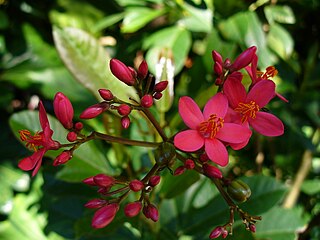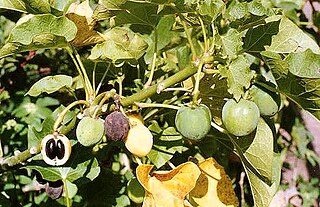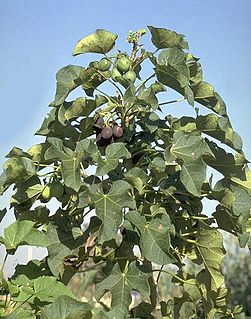Related Research Articles

Jatropha is a genus of flowering plants in the spurge family, Euphorbiaceae. The name is derived from the Greek words ἰατρός (iatros), meaning "physician", and τροφή (trophe), meaning "nutrition", hence the common name physic nut. Another common name is nettlespurge. It contains approximately 170 species of succulent plants, shrubs and trees. Most of these are native to the Americas, with 66 species found in the Old World. Plants produce separate male and female flowers. As with many members of the family Euphorbiaceae, Jatropha contains compounds that are highly toxic. Jatropha species have traditionally been used in basketmaking, tanning and dye production. In the 2000s, one species, Jatropha curcas, generated interest as an oil crop for biodiesel production and also medicinal importance when used as lamp oil; native Mexicans in the Veracruz area developed by selective breeding a Jatropha curcas variant lacking the toxic compounds, yielding a better income when used as source for biodiesel, because of its edible byproduct. Toxicity may return if edible Jatropha is pollinated by toxic types.

Biofuel development in India centres mainly around the cultivation and processing of Jatropha plant seeds which are very rich in oil (40%). The drivers for this are historic, functional, economic, environmental, moral and political. Jatropha oil has been used in India for several decades as biodiesel for the diesel fuel requirements of remote rural and forest communities; jatropha oil can be used directly after extraction in diesel generators and engines. Jatropha has the potential to provide economic benefits at the local level since under suitable management it has the potential to grow in dry marginal non-agricultural lands, thereby allowing villagers and farmers to leverage non-farm land for income generation. As well, increased Jatropha oil production delivers economic benefits to India on the macroeconomic or national level as it reduces the nation's fossil fuel import bill for diesel production ; minimising the expenditure of India's foreign-currency reserves for fuel allowing India to increase its growing foreign currency reserves. And since Jatropha oil is carbon-neutral, large-scale production will improve the country's carbon emissions profile. Finally, since no food producing farmland is required for producing this biofuel, it is considered the most politically and morally acceptable choice among India's current biofuel options; it has no known negative impact on the production of the massive amounts grains and other vital agriculture goods India produces to meet the food requirements of its massive population. Other biofuels which displace food crops from viable agricultural land such as corn ethanol or palm biodiesel have caused serious price increases for basic food grains and edible oils in other countries.

Jatropha curcas is a species of flowering plant in the spurge family, Euphorbiaceae, that is native to the American tropics, most likely Mexico and Central America. It is originally native to the tropical areas of the Americas from Mexico to Argentina, and has been spread throughout the world in tropical and subtropical regions around the world, becoming naturalized or invasive in many areas. The specific epithet, "curcas", was first used by Portuguese doctor Garcia de Orta more than 400 years ago. Common names in English include physic nut, Barbados nut, poison nut, bubble bush or purging nut. In parts of Africa and areas in Asia such as India it is often known as "castor oil plant" or "hedge castor oil plant", but it is not the same as the usual castor oil plant, Ricinus communis.
Indian cassava mosaic virus(ICMV) is a plant pathogenic virus of the family Geminiviridae. It affects cassava in India and certain other countries. It is considered to be an invasive species.

SG Biofuels is a privately held bioenergy crop company, which grows and researches Jatropha curcas for the production of biodiesel, bio jet fuel, and specialty chemicals.

Stomphastis thraustica is a moth of the family Gracillariidae. It is known from Democratic Republic of Congo, Congo, Central African Republic, Ghana, Nigeria, Namibia, Zimbabwe, South Africa, Madagascar, Malaysia, Indonesia and India. It was recently also recorded from China.
Neurobathra curcassi is a moth of the family Gracillariidae. It is known from Cuba.

Global Clean Energy Holdings (OTC:GCEH) is a Southern California-based renewable energy company focused on the production and commercialization of non-food based feedstocks used for the production of biofuels, biomass and renewable chemicals.
Aureimonas jatrophae is a bacterium from the genus of Aurantimonas which was isolated from the plant Jatropha curcas Linnaeus in the Agrotechnology Experimental Station of Lim Chu Kang in Singapore.
Aureimonas phyllosphaerae is a bacterium from the genus of Aurantimonas which was isolated from the plant Jatropha curcas Linnaeus from an agrotechnology experimental station in Lim Chu Kang in Singapore.
Lasiodiplodia margaritacea is an endophytic fungus that might be a canker pathogen, specifically for Adansonia gibbosa (baobab). It was isolated from said trees, as well as surrounding ones, in the Kimberley.
Lasiodiplodia gilanensis is an endophytic fungus. It was first isolated in Gilan Province, Iran, hence its name. It has since been isolated in other plants in other continents, and is considered a plant pathogen. L. gilanensis is phylogenetically related to L. plurivora, but can be distinguished by its conidial dimensions. Also, the paraphyses of the former are up to 95μm long and 4μm wide, whereas those of L. plurivora are up to 130μm long and 10μm wide. At the same time, the basal 1–3 cells in the paraphyses of L. plurivora are broader than its apical cells.
Pleomorphomonas diazotrophica is a Gram-negative, aerobic, pleomorphic and nitrogen-fixing bacterium species from the genus Pleomorphomonas which has been isolated from root tissue of the plant Jatropha curcas at the agrotechnology experimental station in Singapore.
Nocardioides endophyticus is a Gram-positive, non-spore-forming, rod-shaped and non-motile bacterium from the genus Nocardioides.
Nocardioides perillae is a Gram-positive and rod-shaped bacterium from the genus of Nocardioides which has been isolated from the roots of the plant Perilla frutescens from a suburb of Beijing in China. Nocardioides perillae produces the menaquinone MK-8(H4).
Kibdelosporangium is a Gram-positive genus from the family of Pseudonocardiaceae. Kibdelosporangium bacteria produce substances with antibacterial, anticancer, and antiviral activities.
Kibdelosporangium phytohabitans is a bacterium from the genus of Kibdelosporangium which has been isolated from seeds from the plant Jatropha curcas in Sichuan in China.
Pseudonocardia sichuanensis is a bacterium from the genus of Pseudonocardia which has been isolated from the roots of the plant Jatropha curcas in Panzhihua in China.
Intrasporangium mesophilum is a species of Gram positive, strictly aerobic bacterium. The species was initially isolated from rhizospheric soil of an oilseed plant, Jatropha curcas. The species was first described in 2012, and its name refers to its mesophilic growth conditions.

Bart Muys is a Belgian professor of forest ecology and forest management at the KU Leuven. His research focuses on the ecosystem functioning of tree diversity, the ecology of forest restoration and the evaluation of sustainability in forests and bioenergy systems. He is one of the most cited scientists internationally in the field of silviculture and forest management.
References
- 1 2 Parte, A.C. "Nocardioides". LPSN .
- 1 2 3 "Nocardioides panzhihuensis". www.uniprot.org.
- ↑ Qin, S; Yuan, B; Zhang, YJ; Bian, GK; Tamura, T; Sun, BZ; Li, WJ; Jiang, JH (August 2012). "Nocardioides panzhihuaensis sp. nov., a novel endophytic actinomycete isolated from medicinal plant Jatropha curcas L.". Antonie van Leeuwenhoek. 102 (2): 353–60. doi:10.1007/s10482-012-9745-8. PMID 22552630. S2CID 7772697.
- ↑ "Details: DSM-26487". www.dsmz.de.